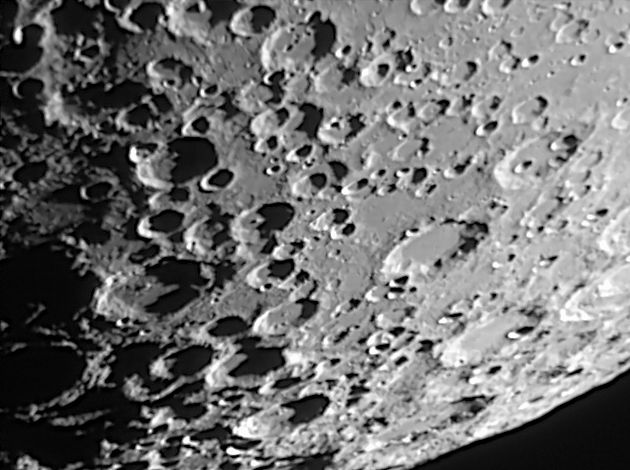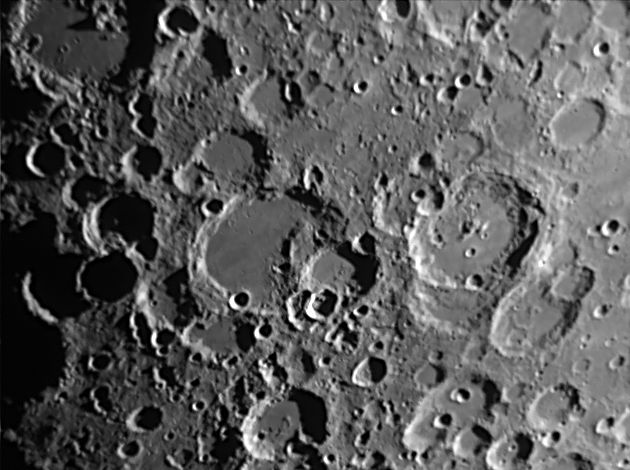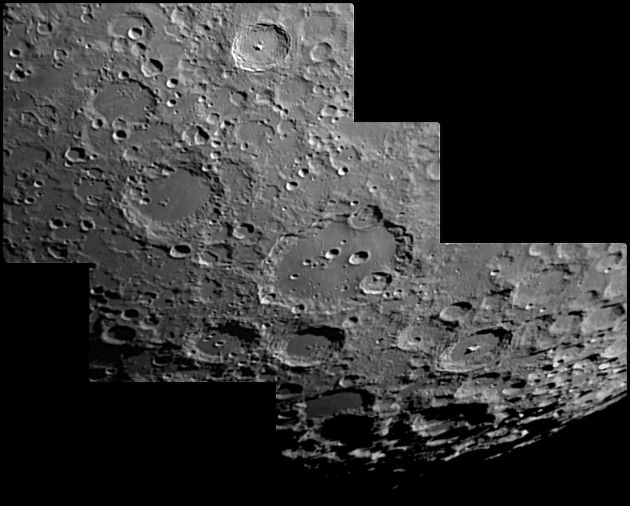Move your mouse over the picture to see the names of the various features.
This first picture is of the eastern part of the southern highlands. Almost all the craters here are ancient, pre-nectarian which is more than 3,900 million years old. Only Curtius and Zach are catalogued as Nectarian but that only makes then some 500 million years younger. Consequently all the craters are softened with no sharp edges. The most interesting feature here is not the craters but the areas in between them. These areas are remarkably smooth and the reason for this is not entirely clear. The areas are not dark enough to be mare basalts unless of course they have been dusted by lighter material from elsewhere, but they are too smooth to be ejecta. Maybe the most likely explanation is that it represents the original lunar surface that formed when the molten Moon first began to solidify. Here is not the place to go into the Moon's origin but it must have been at least partially molten as the accretion that formed it came to an end. The pre-nectarian craters represent the last of these accruing objects whose craters were not obliterated by later impacts. There are strengths and weaknesses in all current theories, which will not be resolved until samples from these area are returned to Earth for analysis.

|
This is the eastern part of the southern highlands.
The picture was taken with a monochrome camera and an IR-pass filter attached to my LX200 on 8th May 2022 at 22:02 UT, when the Moon was 7.3 days old. The scale markers are approximately 100 Km North and East and apply at Pentland.
Date and Time: 8 May 2022 at 22:02 UT
Lunar Phase 91.6°
Colongitude 4.2°
Libration: Latitude -6°10' Longitude -6°1'
Camera: DMK 21AF04
Telescope: LX200 with IR-pass filter
Capture: ICCapture exposure 1/108 sec, gain 823, 3384 frames
Processing: Registax. 2120 frames stacked. Wavelet 1-2 = 10, gamma 1.3
Focus Magic focus 3
|

|
This is an area north of the one above but with no overlap. The interesting thing here is the very flat, featureless floors in Stofler, Fernelius, Kaiser, Buch, and others all of which are classified as pre-nectarian (that is more then 3,900 million years old). Compare with Maurolycus with many superposed craters which is classed as nectarian which is some 50 million years or so younger. How did these four craters avoid secondaries from the formation of Maurolycus and the cause of all the small craters in Maurolycus? Were they infilled later by molten material coming up from below? If so, what?
The picture was taken immediately after the picture above. The scale markers are approximately 100 Km North and East and apply at Faraday.
Date and Time: 8 May 2022 at 22:04 UT
Lunar Phase 91.6°
Colongitude 4.2°
Libration: Latitude -6°10' Longitude -6°1'
Camera: DMK 21AF04
Telescope: LX200 with IR-pass filter
Capture: ICCapture exposure 1/108 sec, gain 823, 3382 frames
Processing: Registax. 1696 frames stacked. Wavelet 1-2 = 10, gamma 1.3
Focus Magic focus 2
|

|
Taken three days later, on Day 10.1, here is a 3-frame mosaic of the area covered by the two pictures above. Click on the image to see it full scale.
The scale markers are approximately 100 Km North and East and apply at Rutherfurd.
Date and Time: 11 May 2022 at 21:13 to 21:22 UT
Lunar Phase 56.4°
Colongitude 40.9°
Libration: Latitude -5° 5' Longitude -7° 6'
Camera: DMK 21AF04
Telescope: LX200 with IR-pass filter
Capture: ICCapture exposure 1/500 sec, gain 962, 3402 to 3753 frames
Processing: Registax. ~2000 frames stacked. Wavelet 1-2 = 10, gamma 1.3
Focus Magic focus width 2
|

